Report on Learning Culture and Skill Development at Blitzen
VerifiedAdded on 2019/12/18
|12
|3330
|187
Report
AI Summary
This report provides a comprehensive analysis of the learning culture within Blitzen Engineering, a supplier of automotive components. It delves into the company's challenges, particularly concerning an aging workforce and the need to adapt to technological advancements. The report identifies issues related to skill development, barriers to creating a learning culture, and the benefits of investing in workforce skill development programs. It also examines the drawbacks of the 'one size fits all' approach. Furthermore, the report offers recommendations for the HR manager, including learning requirements, appropriate learning methods, expectations for continuous improvement, and assessment strategies for developing a robust learning culture. The analysis highlights the importance of adapting to technological changes and fostering a continuous learning environment within the organization to remain competitive.

Assignment
Learning Culture
Student Name:
Student ID:
College Name:
College ID:
1
Learning Culture
Student Name:
Student ID:
College Name:
College ID:
1
Paraphrase This Document
Need a fresh take? Get an instant paraphrase of this document with our AI Paraphraser
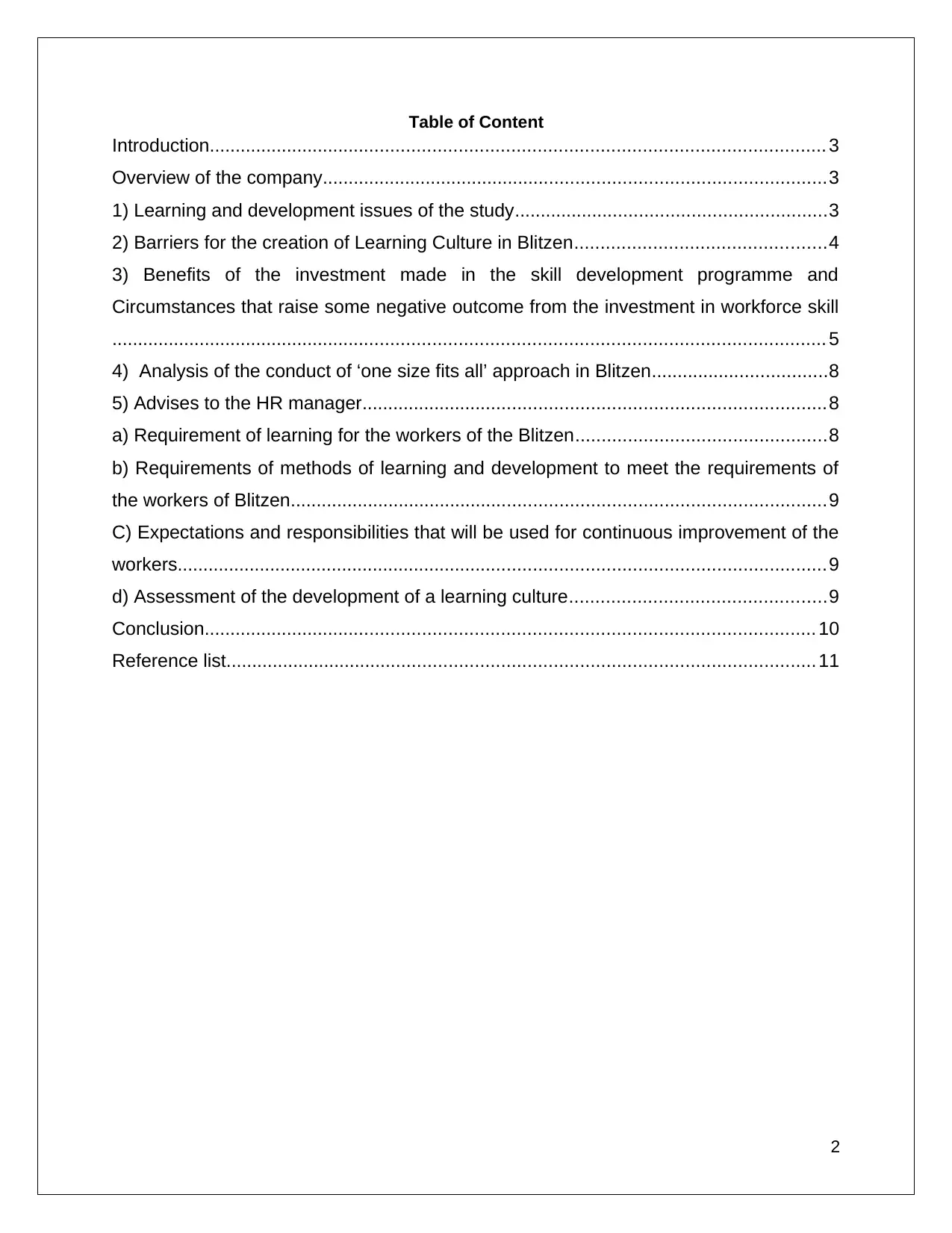
Table of Content
Introduction...................................................................................................................... 3
Overview of the company.................................................................................................3
1) Learning and development issues of the study............................................................3
2) Barriers for the creation of Learning Culture in Blitzen................................................4
3) Benefits of the investment made in the skill development programme and
Circumstances that raise some negative outcome from the investment in workforce skill
......................................................................................................................................... 5
4) Analysis of the conduct of ‘one size fits all’ approach in Blitzen..................................8
5) Advises to the HR manager.........................................................................................8
a) Requirement of learning for the workers of the Blitzen................................................8
b) Requirements of methods of learning and development to meet the requirements of
the workers of Blitzen.......................................................................................................9
C) Expectations and responsibilities that will be used for continuous improvement of the
workers.............................................................................................................................9
d) Assessment of the development of a learning culture.................................................9
Conclusion..................................................................................................................... 10
Reference list................................................................................................................. 11
2
Introduction...................................................................................................................... 3
Overview of the company.................................................................................................3
1) Learning and development issues of the study............................................................3
2) Barriers for the creation of Learning Culture in Blitzen................................................4
3) Benefits of the investment made in the skill development programme and
Circumstances that raise some negative outcome from the investment in workforce skill
......................................................................................................................................... 5
4) Analysis of the conduct of ‘one size fits all’ approach in Blitzen..................................8
5) Advises to the HR manager.........................................................................................8
a) Requirement of learning for the workers of the Blitzen................................................8
b) Requirements of methods of learning and development to meet the requirements of
the workers of Blitzen.......................................................................................................9
C) Expectations and responsibilities that will be used for continuous improvement of the
workers.............................................................................................................................9
d) Assessment of the development of a learning culture.................................................9
Conclusion..................................................................................................................... 10
Reference list................................................................................................................. 11
2
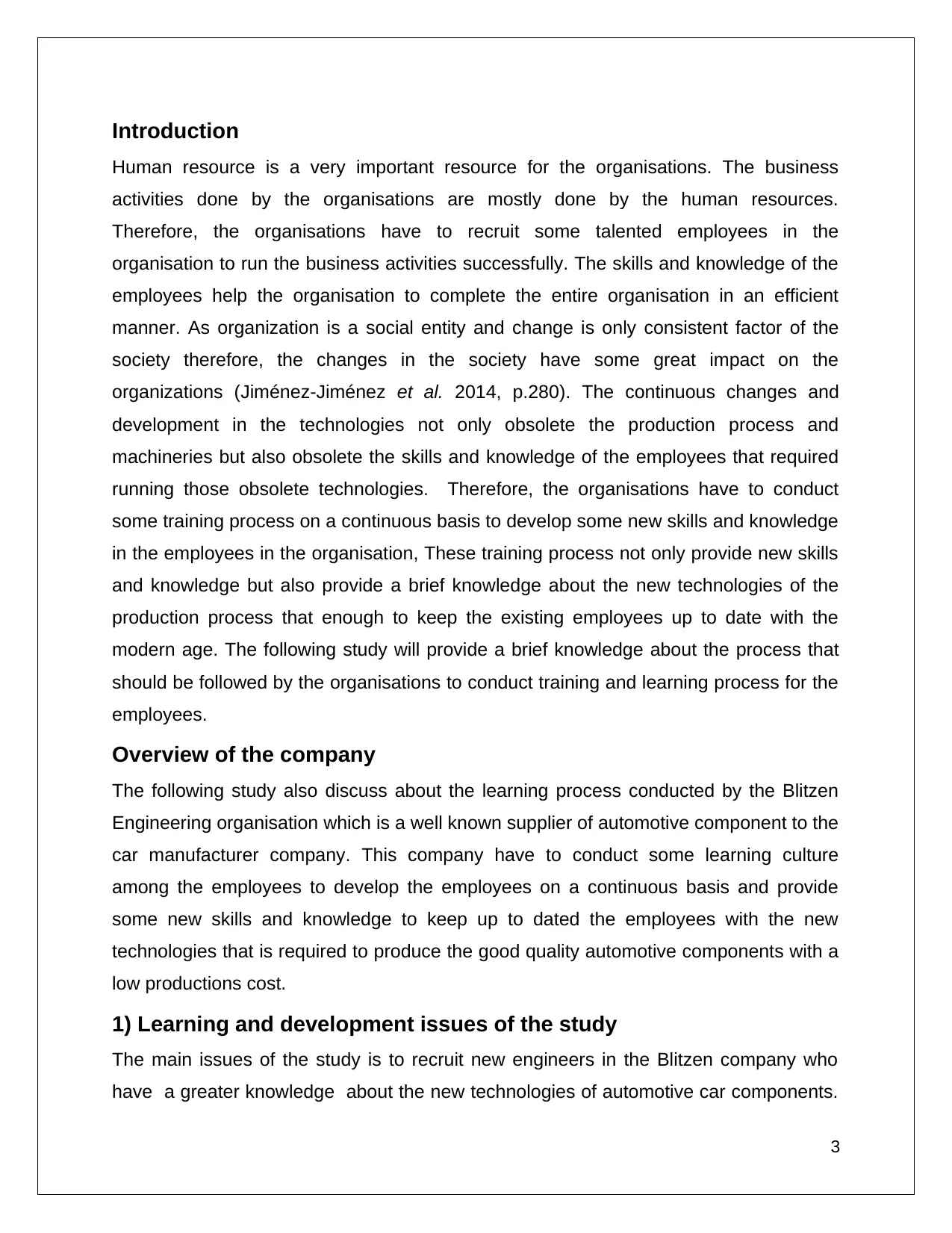
Introduction
Human resource is a very important resource for the organisations. The business
activities done by the organisations are mostly done by the human resources.
Therefore, the organisations have to recruit some talented employees in the
organisation to run the business activities successfully. The skills and knowledge of the
employees help the organisation to complete the entire organisation in an efficient
manner. As organization is a social entity and change is only consistent factor of the
society therefore, the changes in the society have some great impact on the
organizations (Jiménez-Jiménez et al. 2014, p.280). The continuous changes and
development in the technologies not only obsolete the production process and
machineries but also obsolete the skills and knowledge of the employees that required
running those obsolete technologies. Therefore, the organisations have to conduct
some training process on a continuous basis to develop some new skills and knowledge
in the employees in the organisation, These training process not only provide new skills
and knowledge but also provide a brief knowledge about the new technologies of the
production process that enough to keep the existing employees up to date with the
modern age. The following study will provide a brief knowledge about the process that
should be followed by the organisations to conduct training and learning process for the
employees.
Overview of the company
The following study also discuss about the learning process conducted by the Blitzen
Engineering organisation which is a well known supplier of automotive component to the
car manufacturer company. This company have to conduct some learning culture
among the employees to develop the employees on a continuous basis and provide
some new skills and knowledge to keep up to dated the employees with the new
technologies that is required to produce the good quality automotive components with a
low productions cost.
1) Learning and development issues of the study
The main issues of the study is to recruit new engineers in the Blitzen company who
have a greater knowledge about the new technologies of automotive car components.
3
Human resource is a very important resource for the organisations. The business
activities done by the organisations are mostly done by the human resources.
Therefore, the organisations have to recruit some talented employees in the
organisation to run the business activities successfully. The skills and knowledge of the
employees help the organisation to complete the entire organisation in an efficient
manner. As organization is a social entity and change is only consistent factor of the
society therefore, the changes in the society have some great impact on the
organizations (Jiménez-Jiménez et al. 2014, p.280). The continuous changes and
development in the technologies not only obsolete the production process and
machineries but also obsolete the skills and knowledge of the employees that required
running those obsolete technologies. Therefore, the organisations have to conduct
some training process on a continuous basis to develop some new skills and knowledge
in the employees in the organisation, These training process not only provide new skills
and knowledge but also provide a brief knowledge about the new technologies of the
production process that enough to keep the existing employees up to date with the
modern age. The following study will provide a brief knowledge about the process that
should be followed by the organisations to conduct training and learning process for the
employees.
Overview of the company
The following study also discuss about the learning process conducted by the Blitzen
Engineering organisation which is a well known supplier of automotive component to the
car manufacturer company. This company have to conduct some learning culture
among the employees to develop the employees on a continuous basis and provide
some new skills and knowledge to keep up to dated the employees with the new
technologies that is required to produce the good quality automotive components with a
low productions cost.
1) Learning and development issues of the study
The main issues of the study is to recruit new engineers in the Blitzen company who
have a greater knowledge about the new technologies of automotive car components.
3
⊘ This is a preview!⊘
Do you want full access?
Subscribe today to unlock all pages.

Trusted by 1+ million students worldwide
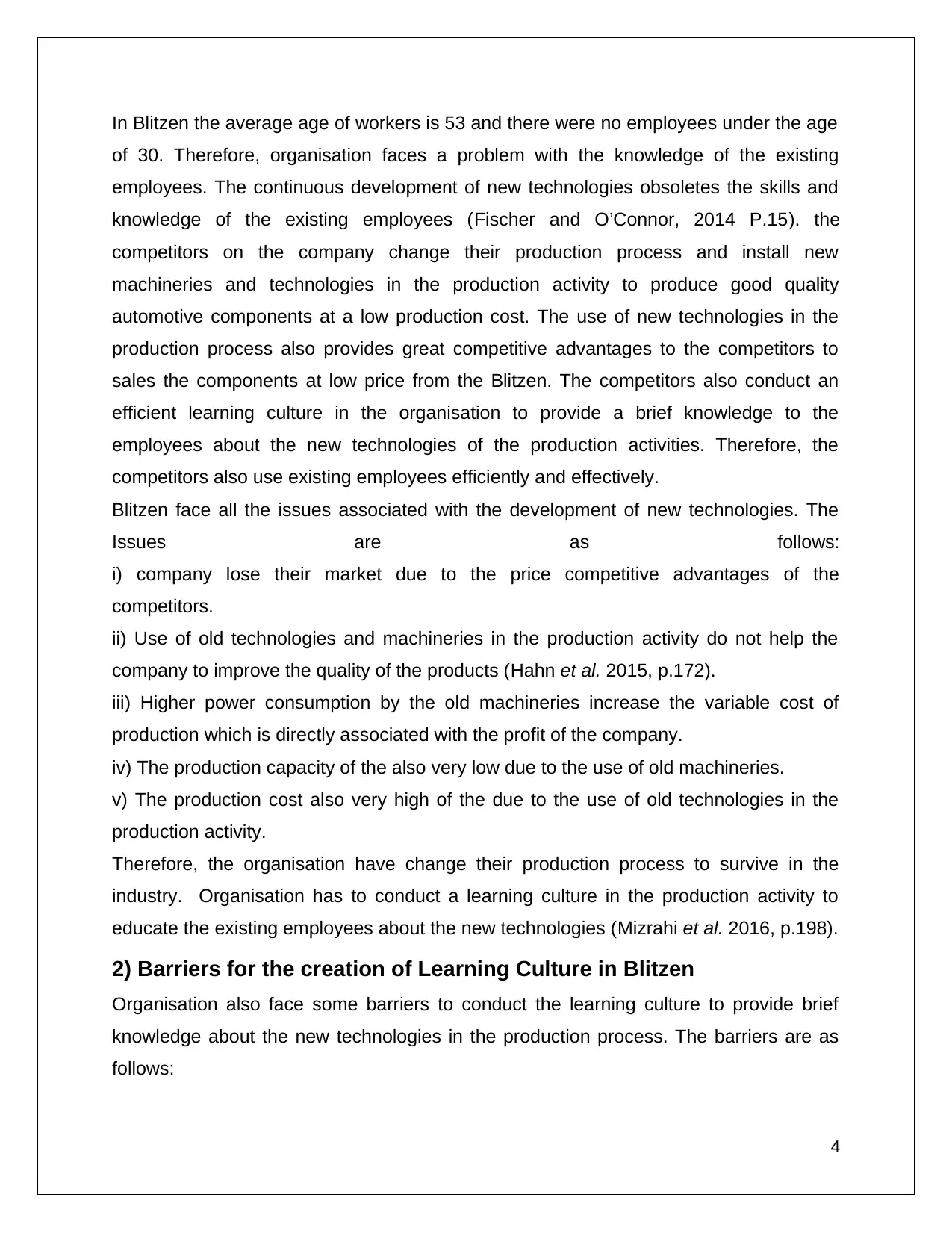
In Blitzen the average age of workers is 53 and there were no employees under the age
of 30. Therefore, organisation faces a problem with the knowledge of the existing
employees. The continuous development of new technologies obsoletes the skills and
knowledge of the existing employees (Fischer and O’Connor, 2014 P.15). the
competitors on the company change their production process and install new
machineries and technologies in the production activity to produce good quality
automotive components at a low production cost. The use of new technologies in the
production process also provides great competitive advantages to the competitors to
sales the components at low price from the Blitzen. The competitors also conduct an
efficient learning culture in the organisation to provide a brief knowledge to the
employees about the new technologies of the production activities. Therefore, the
competitors also use existing employees efficiently and effectively.
Blitzen face all the issues associated with the development of new technologies. The
Issues are as follows:
i) company lose their market due to the price competitive advantages of the
competitors.
ii) Use of old technologies and machineries in the production activity do not help the
company to improve the quality of the products (Hahn et al. 2015, p.172).
iii) Higher power consumption by the old machineries increase the variable cost of
production which is directly associated with the profit of the company.
iv) The production capacity of the also very low due to the use of old machineries.
v) The production cost also very high of the due to the use of old technologies in the
production activity.
Therefore, the organisation have change their production process to survive in the
industry. Organisation has to conduct a learning culture in the production activity to
educate the existing employees about the new technologies (Mizrahi et al. 2016, p.198).
2) Barriers for the creation of Learning Culture in Blitzen
Organisation also face some barriers to conduct the learning culture to provide brief
knowledge about the new technologies in the production process. The barriers are as
follows:
4
of 30. Therefore, organisation faces a problem with the knowledge of the existing
employees. The continuous development of new technologies obsoletes the skills and
knowledge of the existing employees (Fischer and O’Connor, 2014 P.15). the
competitors on the company change their production process and install new
machineries and technologies in the production activity to produce good quality
automotive components at a low production cost. The use of new technologies in the
production process also provides great competitive advantages to the competitors to
sales the components at low price from the Blitzen. The competitors also conduct an
efficient learning culture in the organisation to provide a brief knowledge to the
employees about the new technologies of the production activities. Therefore, the
competitors also use existing employees efficiently and effectively.
Blitzen face all the issues associated with the development of new technologies. The
Issues are as follows:
i) company lose their market due to the price competitive advantages of the
competitors.
ii) Use of old technologies and machineries in the production activity do not help the
company to improve the quality of the products (Hahn et al. 2015, p.172).
iii) Higher power consumption by the old machineries increase the variable cost of
production which is directly associated with the profit of the company.
iv) The production capacity of the also very low due to the use of old machineries.
v) The production cost also very high of the due to the use of old technologies in the
production activity.
Therefore, the organisation have change their production process to survive in the
industry. Organisation has to conduct a learning culture in the production activity to
educate the existing employees about the new technologies (Mizrahi et al. 2016, p.198).
2) Barriers for the creation of Learning Culture in Blitzen
Organisation also face some barriers to conduct the learning culture to provide brief
knowledge about the new technologies in the production process. The barriers are as
follows:
4
Paraphrase This Document
Need a fresh take? Get an instant paraphrase of this document with our AI Paraphraser
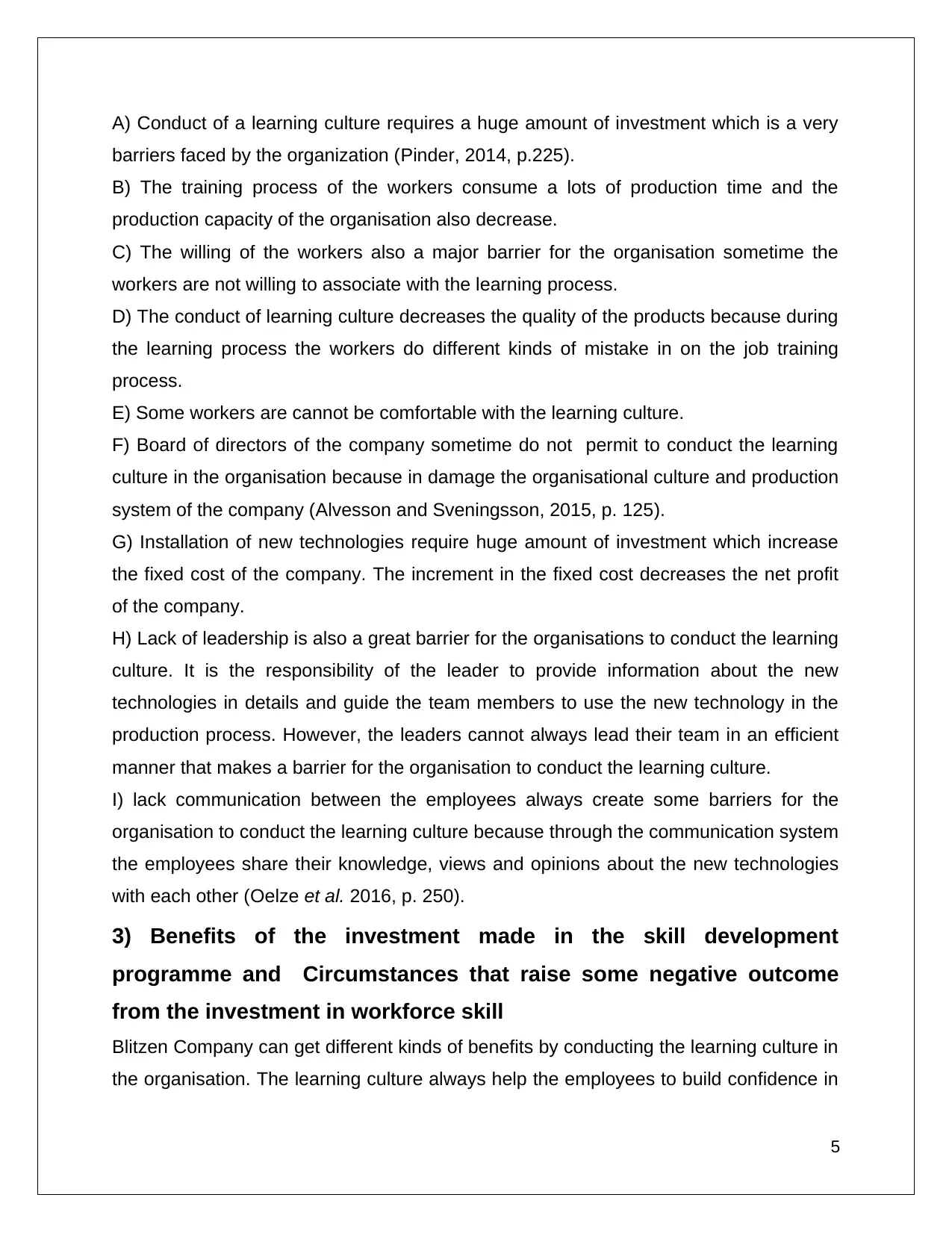
A) Conduct of a learning culture requires a huge amount of investment which is a very
barriers faced by the organization (Pinder, 2014, p.225).
B) The training process of the workers consume a lots of production time and the
production capacity of the organisation also decrease.
C) The willing of the workers also a major barrier for the organisation sometime the
workers are not willing to associate with the learning process.
D) The conduct of learning culture decreases the quality of the products because during
the learning process the workers do different kinds of mistake in on the job training
process.
E) Some workers are cannot be comfortable with the learning culture.
F) Board of directors of the company sometime do not permit to conduct the learning
culture in the organisation because in damage the organisational culture and production
system of the company (Alvesson and Sveningsson, 2015, p. 125).
G) Installation of new technologies require huge amount of investment which increase
the fixed cost of the company. The increment in the fixed cost decreases the net profit
of the company.
H) Lack of leadership is also a great barrier for the organisations to conduct the learning
culture. It is the responsibility of the leader to provide information about the new
technologies in details and guide the team members to use the new technology in the
production process. However, the leaders cannot always lead their team in an efficient
manner that makes a barrier for the organisation to conduct the learning culture.
I) lack communication between the employees always create some barriers for the
organisation to conduct the learning culture because through the communication system
the employees share their knowledge, views and opinions about the new technologies
with each other (Oelze et al. 2016, p. 250).
3) Benefits of the investment made in the skill development
programme and Circumstances that raise some negative outcome
from the investment in workforce skill
Blitzen Company can get different kinds of benefits by conducting the learning culture in
the organisation. The learning culture always help the employees to build confidence in
5
barriers faced by the organization (Pinder, 2014, p.225).
B) The training process of the workers consume a lots of production time and the
production capacity of the organisation also decrease.
C) The willing of the workers also a major barrier for the organisation sometime the
workers are not willing to associate with the learning process.
D) The conduct of learning culture decreases the quality of the products because during
the learning process the workers do different kinds of mistake in on the job training
process.
E) Some workers are cannot be comfortable with the learning culture.
F) Board of directors of the company sometime do not permit to conduct the learning
culture in the organisation because in damage the organisational culture and production
system of the company (Alvesson and Sveningsson, 2015, p. 125).
G) Installation of new technologies require huge amount of investment which increase
the fixed cost of the company. The increment in the fixed cost decreases the net profit
of the company.
H) Lack of leadership is also a great barrier for the organisations to conduct the learning
culture. It is the responsibility of the leader to provide information about the new
technologies in details and guide the team members to use the new technology in the
production process. However, the leaders cannot always lead their team in an efficient
manner that makes a barrier for the organisation to conduct the learning culture.
I) lack communication between the employees always create some barriers for the
organisation to conduct the learning culture because through the communication system
the employees share their knowledge, views and opinions about the new technologies
with each other (Oelze et al. 2016, p. 250).
3) Benefits of the investment made in the skill development
programme and Circumstances that raise some negative outcome
from the investment in workforce skill
Blitzen Company can get different kinds of benefits by conducting the learning culture in
the organisation. The learning culture always help the employees to build confidence in
5
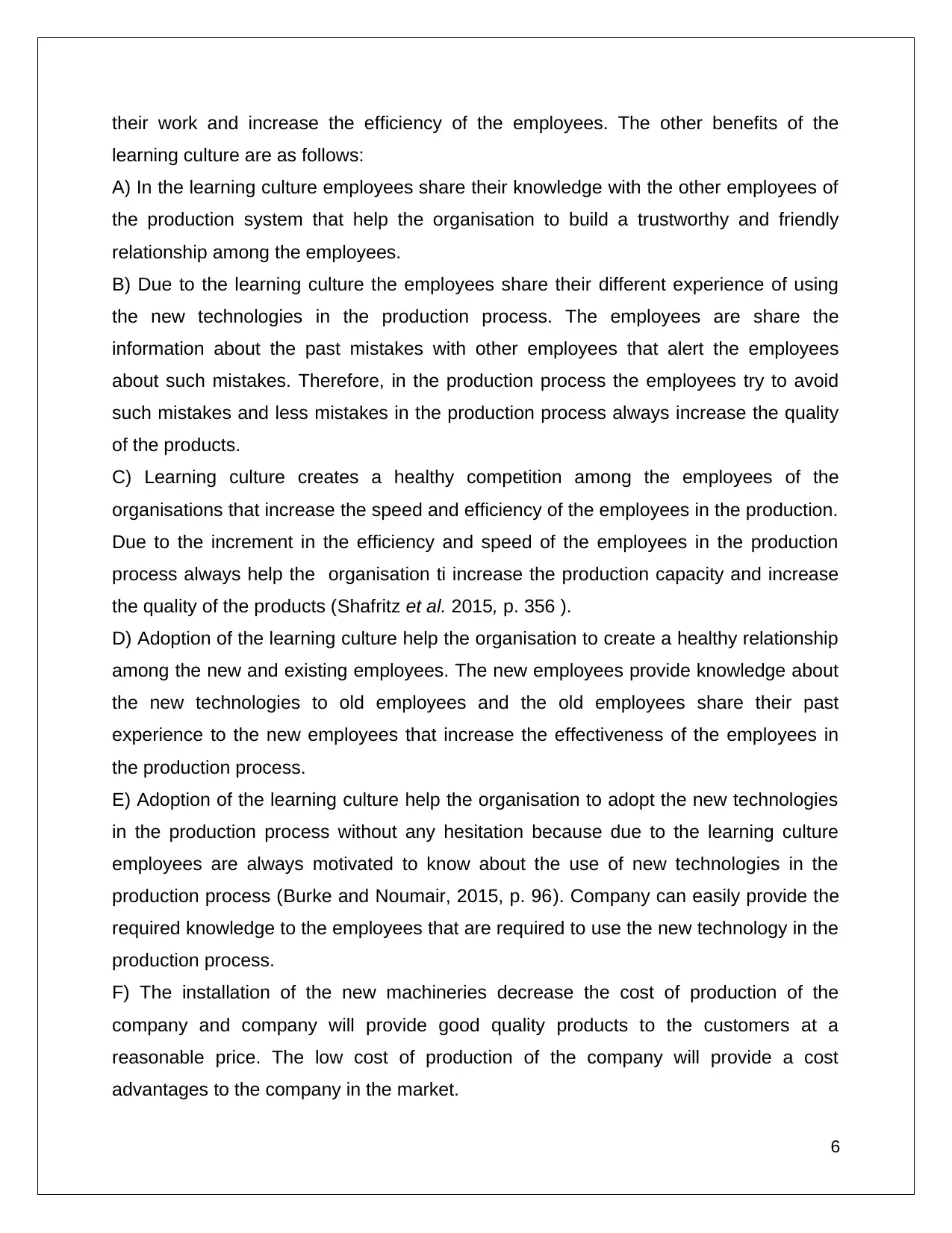
their work and increase the efficiency of the employees. The other benefits of the
learning culture are as follows:
A) In the learning culture employees share their knowledge with the other employees of
the production system that help the organisation to build a trustworthy and friendly
relationship among the employees.
B) Due to the learning culture the employees share their different experience of using
the new technologies in the production process. The employees are share the
information about the past mistakes with other employees that alert the employees
about such mistakes. Therefore, in the production process the employees try to avoid
such mistakes and less mistakes in the production process always increase the quality
of the products.
C) Learning culture creates a healthy competition among the employees of the
organisations that increase the speed and efficiency of the employees in the production.
Due to the increment in the efficiency and speed of the employees in the production
process always help the organisation ti increase the production capacity and increase
the quality of the products (Shafritz et al. 2015, p. 356 ).
D) Adoption of the learning culture help the organisation to create a healthy relationship
among the new and existing employees. The new employees provide knowledge about
the new technologies to old employees and the old employees share their past
experience to the new employees that increase the effectiveness of the employees in
the production process.
E) Adoption of the learning culture help the organisation to adopt the new technologies
in the production process without any hesitation because due to the learning culture
employees are always motivated to know about the use of new technologies in the
production process (Burke and Noumair, 2015, p. 96). Company can easily provide the
required knowledge to the employees that are required to use the new technology in the
production process.
F) The installation of the new machineries decrease the cost of production of the
company and company will provide good quality products to the customers at a
reasonable price. The low cost of production of the company will provide a cost
advantages to the company in the market.
6
learning culture are as follows:
A) In the learning culture employees share their knowledge with the other employees of
the production system that help the organisation to build a trustworthy and friendly
relationship among the employees.
B) Due to the learning culture the employees share their different experience of using
the new technologies in the production process. The employees are share the
information about the past mistakes with other employees that alert the employees
about such mistakes. Therefore, in the production process the employees try to avoid
such mistakes and less mistakes in the production process always increase the quality
of the products.
C) Learning culture creates a healthy competition among the employees of the
organisations that increase the speed and efficiency of the employees in the production.
Due to the increment in the efficiency and speed of the employees in the production
process always help the organisation ti increase the production capacity and increase
the quality of the products (Shafritz et al. 2015, p. 356 ).
D) Adoption of the learning culture help the organisation to create a healthy relationship
among the new and existing employees. The new employees provide knowledge about
the new technologies to old employees and the old employees share their past
experience to the new employees that increase the effectiveness of the employees in
the production process.
E) Adoption of the learning culture help the organisation to adopt the new technologies
in the production process without any hesitation because due to the learning culture
employees are always motivated to know about the use of new technologies in the
production process (Burke and Noumair, 2015, p. 96). Company can easily provide the
required knowledge to the employees that are required to use the new technology in the
production process.
F) The installation of the new machineries decrease the cost of production of the
company and company will provide good quality products to the customers at a
reasonable price. The low cost of production of the company will provide a cost
advantages to the company in the market.
6
⊘ This is a preview!⊘
Do you want full access?
Subscribe today to unlock all pages.

Trusted by 1+ million students worldwide
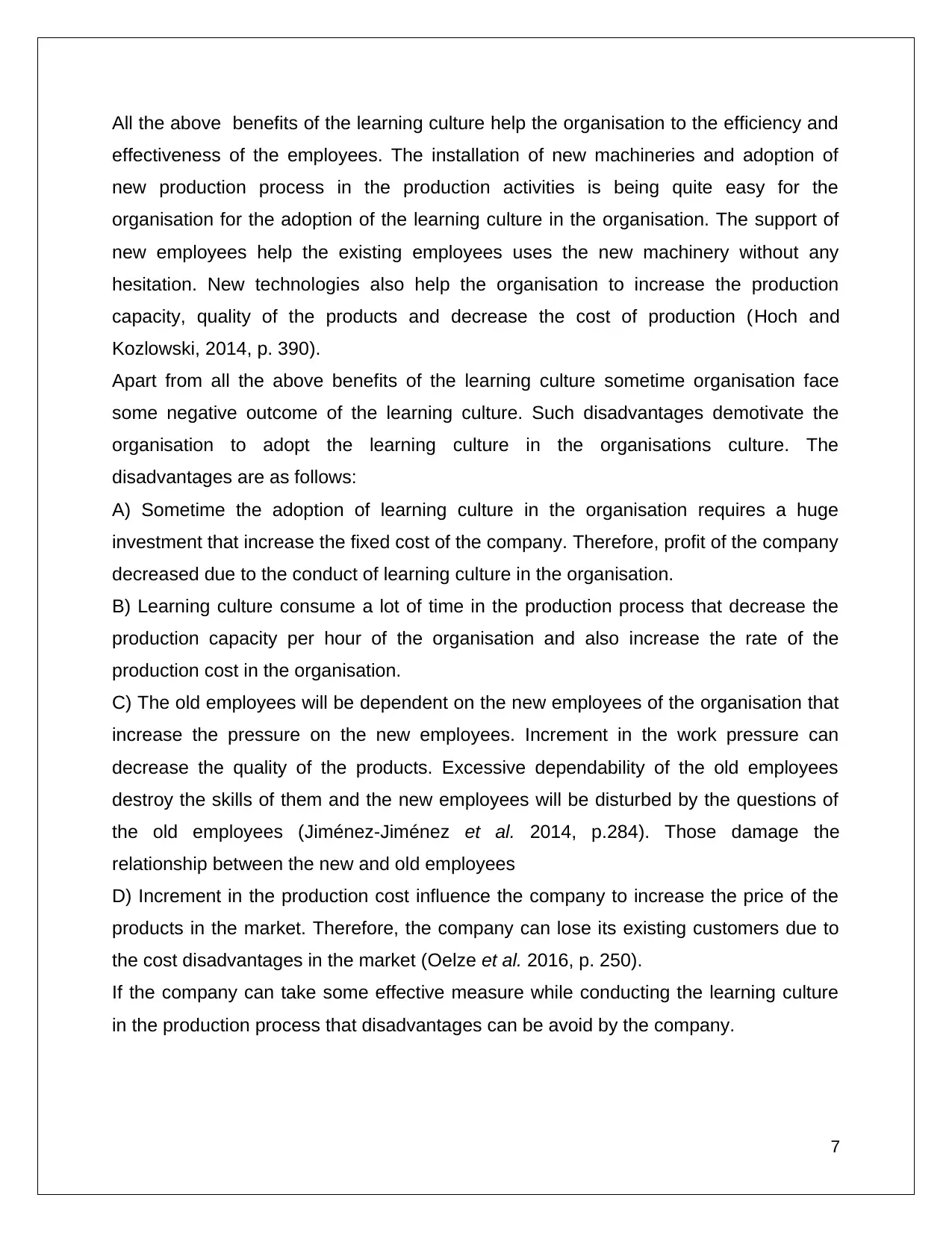
All the above benefits of the learning culture help the organisation to the efficiency and
effectiveness of the employees. The installation of new machineries and adoption of
new production process in the production activities is being quite easy for the
organisation for the adoption of the learning culture in the organisation. The support of
new employees help the existing employees uses the new machinery without any
hesitation. New technologies also help the organisation to increase the production
capacity, quality of the products and decrease the cost of production (Hoch and
Kozlowski, 2014, p. 390).
Apart from all the above benefits of the learning culture sometime organisation face
some negative outcome of the learning culture. Such disadvantages demotivate the
organisation to adopt the learning culture in the organisations culture. The
disadvantages are as follows:
A) Sometime the adoption of learning culture in the organisation requires a huge
investment that increase the fixed cost of the company. Therefore, profit of the company
decreased due to the conduct of learning culture in the organisation.
B) Learning culture consume a lot of time in the production process that decrease the
production capacity per hour of the organisation and also increase the rate of the
production cost in the organisation.
C) The old employees will be dependent on the new employees of the organisation that
increase the pressure on the new employees. Increment in the work pressure can
decrease the quality of the products. Excessive dependability of the old employees
destroy the skills of them and the new employees will be disturbed by the questions of
the old employees (Jiménez-Jiménez et al. 2014, p.284). Those damage the
relationship between the new and old employees
D) Increment in the production cost influence the company to increase the price of the
products in the market. Therefore, the company can lose its existing customers due to
the cost disadvantages in the market (Oelze et al. 2016, p. 250).
If the company can take some effective measure while conducting the learning culture
in the production process that disadvantages can be avoid by the company.
7
effectiveness of the employees. The installation of new machineries and adoption of
new production process in the production activities is being quite easy for the
organisation for the adoption of the learning culture in the organisation. The support of
new employees help the existing employees uses the new machinery without any
hesitation. New technologies also help the organisation to increase the production
capacity, quality of the products and decrease the cost of production (Hoch and
Kozlowski, 2014, p. 390).
Apart from all the above benefits of the learning culture sometime organisation face
some negative outcome of the learning culture. Such disadvantages demotivate the
organisation to adopt the learning culture in the organisations culture. The
disadvantages are as follows:
A) Sometime the adoption of learning culture in the organisation requires a huge
investment that increase the fixed cost of the company. Therefore, profit of the company
decreased due to the conduct of learning culture in the organisation.
B) Learning culture consume a lot of time in the production process that decrease the
production capacity per hour of the organisation and also increase the rate of the
production cost in the organisation.
C) The old employees will be dependent on the new employees of the organisation that
increase the pressure on the new employees. Increment in the work pressure can
decrease the quality of the products. Excessive dependability of the old employees
destroy the skills of them and the new employees will be disturbed by the questions of
the old employees (Jiménez-Jiménez et al. 2014, p.284). Those damage the
relationship between the new and old employees
D) Increment in the production cost influence the company to increase the price of the
products in the market. Therefore, the company can lose its existing customers due to
the cost disadvantages in the market (Oelze et al. 2016, p. 250).
If the company can take some effective measure while conducting the learning culture
in the production process that disadvantages can be avoid by the company.
7
Paraphrase This Document
Need a fresh take? Get an instant paraphrase of this document with our AI Paraphraser
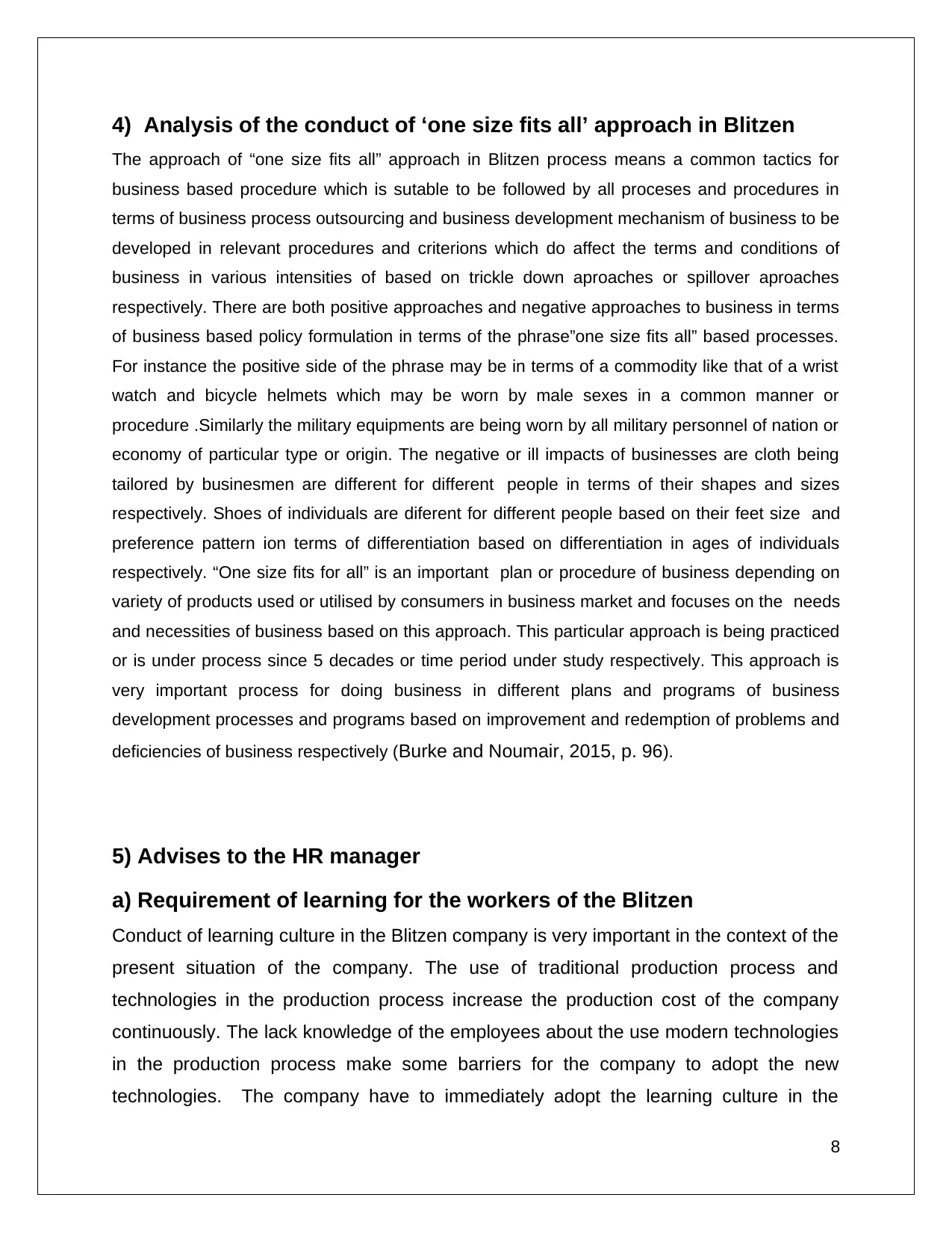
4) Analysis of the conduct of ‘one size fits all’ approach in Blitzen
The approach of “one size fits all” approach in Blitzen process means a common tactics for
business based procedure which is sutable to be followed by all proceses and procedures in
terms of business process outsourcing and business development mechanism of business to be
developed in relevant procedures and criterions which do affect the terms and conditions of
business in various intensities of based on trickle down aproaches or spillover aproaches
respectively. There are both positive approaches and negative approaches to business in terms
of business based policy formulation in terms of the phrase”one size fits all” based processes.
For instance the positive side of the phrase may be in terms of a commodity like that of a wrist
watch and bicycle helmets which may be worn by male sexes in a common manner or
procedure .Similarly the military equipments are being worn by all military personnel of nation or
economy of particular type or origin. The negative or ill impacts of businesses are cloth being
tailored by businesmen are different for different people in terms of their shapes and sizes
respectively. Shoes of individuals are diferent for different people based on their feet size and
preference pattern ion terms of differentiation based on differentiation in ages of individuals
respectively. “One size fits for all” is an important plan or procedure of business depending on
variety of products used or utilised by consumers in business market and focuses on the needs
and necessities of business based on this approach. This particular approach is being practiced
or is under process since 5 decades or time period under study respectively. This approach is
very important process for doing business in different plans and programs of business
development processes and programs based on improvement and redemption of problems and
deficiencies of business respectively (Burke and Noumair, 2015, p. 96).
5) Advises to the HR manager
a) Requirement of learning for the workers of the Blitzen
Conduct of learning culture in the Blitzen company is very important in the context of the
present situation of the company. The use of traditional production process and
technologies in the production process increase the production cost of the company
continuously. The lack knowledge of the employees about the use modern technologies
in the production process make some barriers for the company to adopt the new
technologies. The company have to immediately adopt the learning culture in the
8
The approach of “one size fits all” approach in Blitzen process means a common tactics for
business based procedure which is sutable to be followed by all proceses and procedures in
terms of business process outsourcing and business development mechanism of business to be
developed in relevant procedures and criterions which do affect the terms and conditions of
business in various intensities of based on trickle down aproaches or spillover aproaches
respectively. There are both positive approaches and negative approaches to business in terms
of business based policy formulation in terms of the phrase”one size fits all” based processes.
For instance the positive side of the phrase may be in terms of a commodity like that of a wrist
watch and bicycle helmets which may be worn by male sexes in a common manner or
procedure .Similarly the military equipments are being worn by all military personnel of nation or
economy of particular type or origin. The negative or ill impacts of businesses are cloth being
tailored by businesmen are different for different people in terms of their shapes and sizes
respectively. Shoes of individuals are diferent for different people based on their feet size and
preference pattern ion terms of differentiation based on differentiation in ages of individuals
respectively. “One size fits for all” is an important plan or procedure of business depending on
variety of products used or utilised by consumers in business market and focuses on the needs
and necessities of business based on this approach. This particular approach is being practiced
or is under process since 5 decades or time period under study respectively. This approach is
very important process for doing business in different plans and programs of business
development processes and programs based on improvement and redemption of problems and
deficiencies of business respectively (Burke and Noumair, 2015, p. 96).
5) Advises to the HR manager
a) Requirement of learning for the workers of the Blitzen
Conduct of learning culture in the Blitzen company is very important in the context of the
present situation of the company. The use of traditional production process and
technologies in the production process increase the production cost of the company
continuously. The lack knowledge of the employees about the use modern technologies
in the production process make some barriers for the company to adopt the new
technologies. The company have to immediately adopt the learning culture in the
8
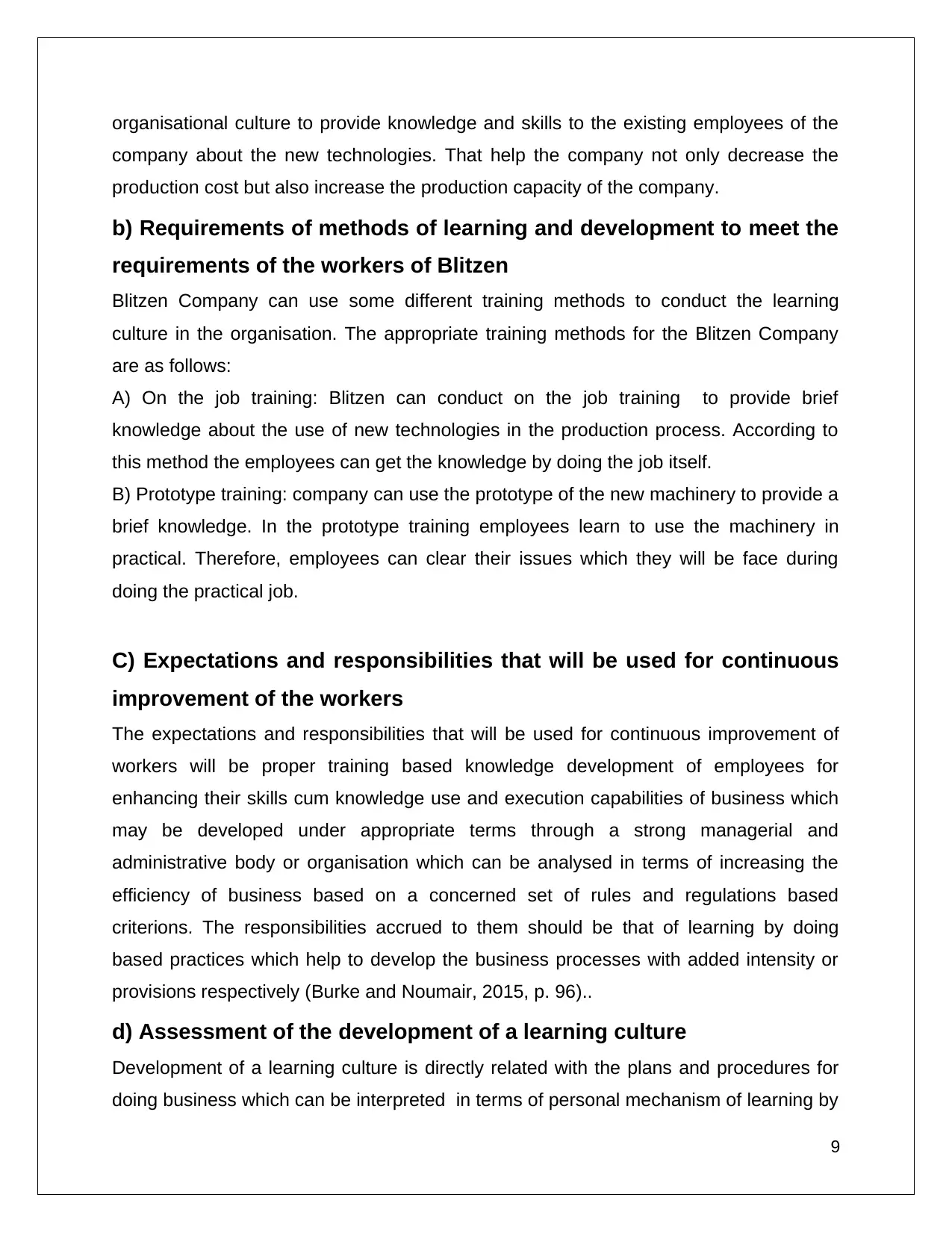
organisational culture to provide knowledge and skills to the existing employees of the
company about the new technologies. That help the company not only decrease the
production cost but also increase the production capacity of the company.
b) Requirements of methods of learning and development to meet the
requirements of the workers of Blitzen
Blitzen Company can use some different training methods to conduct the learning
culture in the organisation. The appropriate training methods for the Blitzen Company
are as follows:
A) On the job training: Blitzen can conduct on the job training to provide brief
knowledge about the use of new technologies in the production process. According to
this method the employees can get the knowledge by doing the job itself.
B) Prototype training: company can use the prototype of the new machinery to provide a
brief knowledge. In the prototype training employees learn to use the machinery in
practical. Therefore, employees can clear their issues which they will be face during
doing the practical job.
C) Expectations and responsibilities that will be used for continuous
improvement of the workers
The expectations and responsibilities that will be used for continuous improvement of
workers will be proper training based knowledge development of employees for
enhancing their skills cum knowledge use and execution capabilities of business which
may be developed under appropriate terms through a strong managerial and
administrative body or organisation which can be analysed in terms of increasing the
efficiency of business based on a concerned set of rules and regulations based
criterions. The responsibilities accrued to them should be that of learning by doing
based practices which help to develop the business processes with added intensity or
provisions respectively (Burke and Noumair, 2015, p. 96)..
d) Assessment of the development of a learning culture
Development of a learning culture is directly related with the plans and procedures for
doing business which can be interpreted in terms of personal mechanism of learning by
9
company about the new technologies. That help the company not only decrease the
production cost but also increase the production capacity of the company.
b) Requirements of methods of learning and development to meet the
requirements of the workers of Blitzen
Blitzen Company can use some different training methods to conduct the learning
culture in the organisation. The appropriate training methods for the Blitzen Company
are as follows:
A) On the job training: Blitzen can conduct on the job training to provide brief
knowledge about the use of new technologies in the production process. According to
this method the employees can get the knowledge by doing the job itself.
B) Prototype training: company can use the prototype of the new machinery to provide a
brief knowledge. In the prototype training employees learn to use the machinery in
practical. Therefore, employees can clear their issues which they will be face during
doing the practical job.
C) Expectations and responsibilities that will be used for continuous
improvement of the workers
The expectations and responsibilities that will be used for continuous improvement of
workers will be proper training based knowledge development of employees for
enhancing their skills cum knowledge use and execution capabilities of business which
may be developed under appropriate terms through a strong managerial and
administrative body or organisation which can be analysed in terms of increasing the
efficiency of business based on a concerned set of rules and regulations based
criterions. The responsibilities accrued to them should be that of learning by doing
based practices which help to develop the business processes with added intensity or
provisions respectively (Burke and Noumair, 2015, p. 96)..
d) Assessment of the development of a learning culture
Development of a learning culture is directly related with the plans and procedures for
doing business which can be interpreted in terms of personal mechanism of learning by
9
⊘ This is a preview!⊘
Do you want full access?
Subscribe today to unlock all pages.

Trusted by 1+ million students worldwide
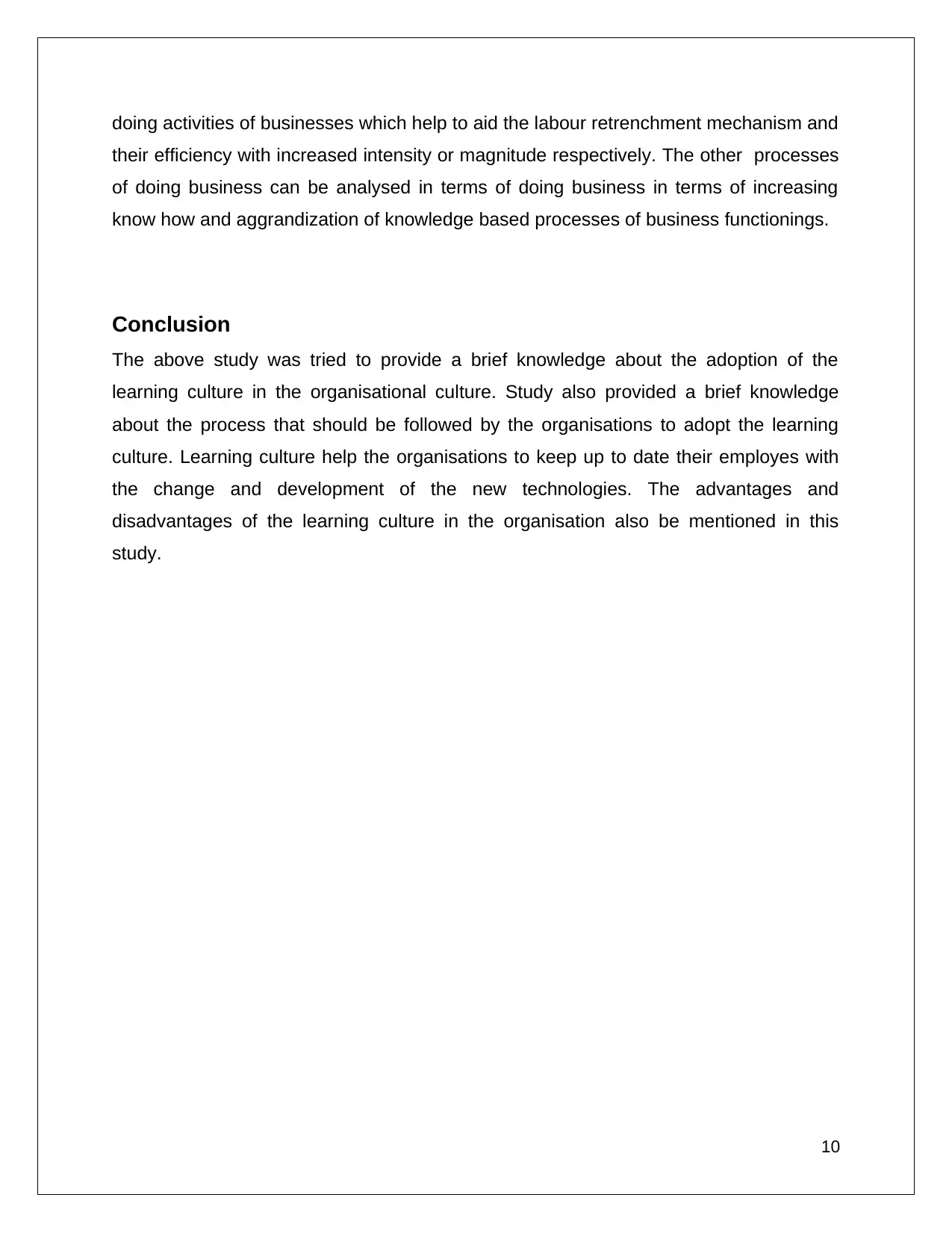
doing activities of businesses which help to aid the labour retrenchment mechanism and
their efficiency with increased intensity or magnitude respectively. The other processes
of doing business can be analysed in terms of doing business in terms of increasing
know how and aggrandization of knowledge based processes of business functionings.
Conclusion
The above study was tried to provide a brief knowledge about the adoption of the
learning culture in the organisational culture. Study also provided a brief knowledge
about the process that should be followed by the organisations to adopt the learning
culture. Learning culture help the organisations to keep up to date their employes with
the change and development of the new technologies. The advantages and
disadvantages of the learning culture in the organisation also be mentioned in this
study.
10
their efficiency with increased intensity or magnitude respectively. The other processes
of doing business can be analysed in terms of doing business in terms of increasing
know how and aggrandization of knowledge based processes of business functionings.
Conclusion
The above study was tried to provide a brief knowledge about the adoption of the
learning culture in the organisational culture. Study also provided a brief knowledge
about the process that should be followed by the organisations to adopt the learning
culture. Learning culture help the organisations to keep up to date their employes with
the change and development of the new technologies. The advantages and
disadvantages of the learning culture in the organisation also be mentioned in this
study.
10
Paraphrase This Document
Need a fresh take? Get an instant paraphrase of this document with our AI Paraphraser
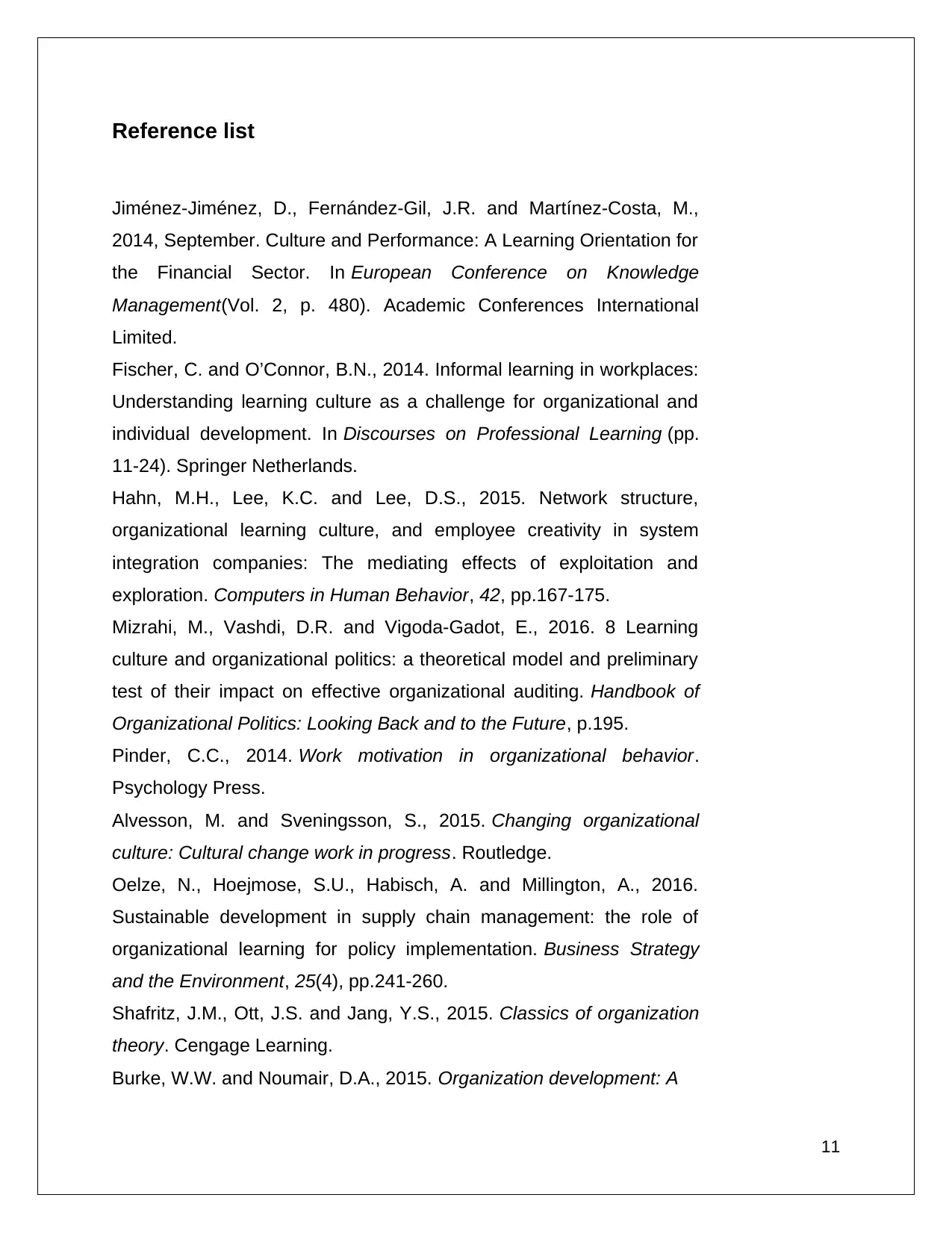
Reference list
Jiménez-Jiménez, D., Fernández-Gil, J.R. and Martínez-Costa, M.,
2014, September. Culture and Performance: A Learning Orientation for
the Financial Sector. In European Conference on Knowledge
Management(Vol. 2, p. 480). Academic Conferences International
Limited.
Fischer, C. and O’Connor, B.N., 2014. Informal learning in workplaces:
Understanding learning culture as a challenge for organizational and
individual development. In Discourses on Professional Learning (pp.
11-24). Springer Netherlands.
Hahn, M.H., Lee, K.C. and Lee, D.S., 2015. Network structure,
organizational learning culture, and employee creativity in system
integration companies: The mediating effects of exploitation and
exploration. Computers in Human Behavior, 42, pp.167-175.
Mizrahi, M., Vashdi, D.R. and Vigoda-Gadot, E., 2016. 8 Learning
culture and organizational politics: a theoretical model and preliminary
test of their impact on effective organizational auditing. Handbook of
Organizational Politics: Looking Back and to the Future, p.195.
Pinder, C.C., 2014. Work motivation in organizational behavior.
Psychology Press.
Alvesson, M. and Sveningsson, S., 2015. Changing organizational
culture: Cultural change work in progress. Routledge.
Oelze, N., Hoejmose, S.U., Habisch, A. and Millington, A., 2016.
Sustainable development in supply chain management: the role of
organizational learning for policy implementation. Business Strategy
and the Environment, 25(4), pp.241-260.
Shafritz, J.M., Ott, J.S. and Jang, Y.S., 2015. Classics of organization
theory. Cengage Learning.
Burke, W.W. and Noumair, D.A., 2015. Organization development: A
11
Jiménez-Jiménez, D., Fernández-Gil, J.R. and Martínez-Costa, M.,
2014, September. Culture and Performance: A Learning Orientation for
the Financial Sector. In European Conference on Knowledge
Management(Vol. 2, p. 480). Academic Conferences International
Limited.
Fischer, C. and O’Connor, B.N., 2014. Informal learning in workplaces:
Understanding learning culture as a challenge for organizational and
individual development. In Discourses on Professional Learning (pp.
11-24). Springer Netherlands.
Hahn, M.H., Lee, K.C. and Lee, D.S., 2015. Network structure,
organizational learning culture, and employee creativity in system
integration companies: The mediating effects of exploitation and
exploration. Computers in Human Behavior, 42, pp.167-175.
Mizrahi, M., Vashdi, D.R. and Vigoda-Gadot, E., 2016. 8 Learning
culture and organizational politics: a theoretical model and preliminary
test of their impact on effective organizational auditing. Handbook of
Organizational Politics: Looking Back and to the Future, p.195.
Pinder, C.C., 2014. Work motivation in organizational behavior.
Psychology Press.
Alvesson, M. and Sveningsson, S., 2015. Changing organizational
culture: Cultural change work in progress. Routledge.
Oelze, N., Hoejmose, S.U., Habisch, A. and Millington, A., 2016.
Sustainable development in supply chain management: the role of
organizational learning for policy implementation. Business Strategy
and the Environment, 25(4), pp.241-260.
Shafritz, J.M., Ott, J.S. and Jang, Y.S., 2015. Classics of organization
theory. Cengage Learning.
Burke, W.W. and Noumair, D.A., 2015. Organization development: A
11
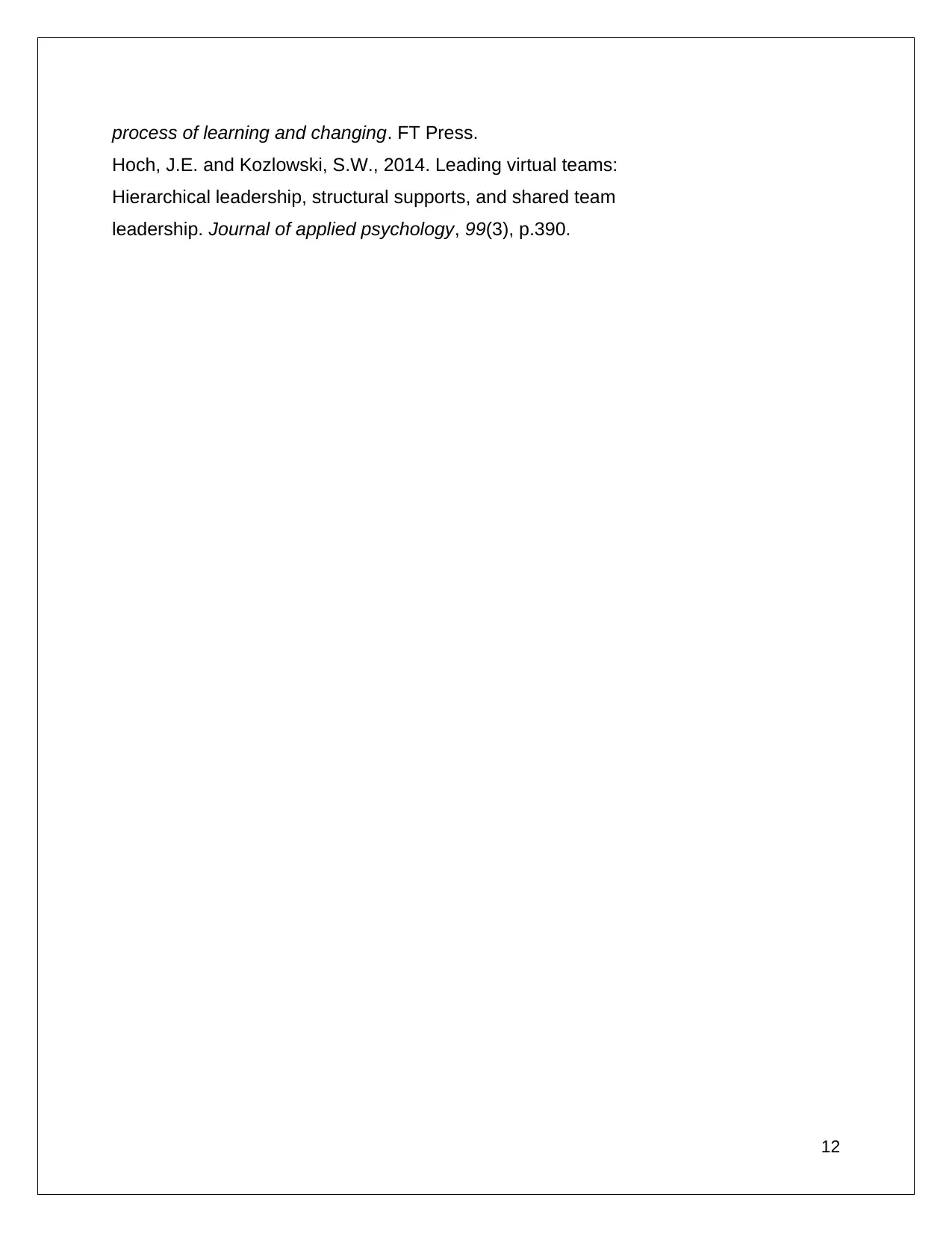
process of learning and changing. FT Press.
Hoch, J.E. and Kozlowski, S.W., 2014. Leading virtual teams:
Hierarchical leadership, structural supports, and shared team
leadership. Journal of applied psychology, 99(3), p.390.
12
Hoch, J.E. and Kozlowski, S.W., 2014. Leading virtual teams:
Hierarchical leadership, structural supports, and shared team
leadership. Journal of applied psychology, 99(3), p.390.
12
⊘ This is a preview!⊘
Do you want full access?
Subscribe today to unlock all pages.

Trusted by 1+ million students worldwide
1 out of 12
Related Documents
Your All-in-One AI-Powered Toolkit for Academic Success.
+13062052269
info@desklib.com
Available 24*7 on WhatsApp / Email
![[object Object]](/_next/static/media/star-bottom.7253800d.svg)
Unlock your academic potential
Copyright © 2020–2025 A2Z Services. All Rights Reserved. Developed and managed by ZUCOL.





